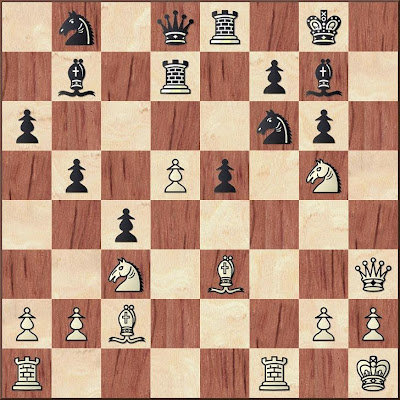Stripes,J (2121) -- Internet Opponent (2325) [A67]
chess.com championships - Round 3 Chess.com, 28.04.2013
1.d4 Nf6 2.c4 c5 3.d5 e6 4.Nc3 exd5 5.cxd5 d6 6.e4 g6 7.f4 Bg7 8.Bb5+
Black to move
When I was playing the Benoni as often as possible several years ago, the Flick-Knife Attack gave me the most trouble.
8...Nfd7
Some of the trouble that I faced was due to playing 8...Nbd7 here. In consequence of playing the wrong knight, White's thematic e4-e5 comes immediately.
9.Nf3!?
I opted for the third most popular move here, in part to test the level of my opponent's preparation. In The Modern Benoni (1994), David Norwood alleges that this move is purposeless as it permits Black to go through with the usual queenside expansion. Norwood asserts that 9.a4 is the correct move.
9...a6 10.Bd3 b5 11.0–0 0–0 12.Kh1 Re8
White to move
This position appears a mere 72 times in ChessBase Online, and yet it should seem to be the most likely position after White's uncommon 9.Nf3. Indeed, this position is found in line 4 of A67 in the Encyclopedia of Chess Openings. The principal move given there is 13.Qe1. Reference games are presented also for 13.Be3, which is not recommended, and 13.Bc2.
13.f5
Before I played my ninth move, I had looked forward in the databases and had gone through several games that reached this position. These games were in the spirit of an all out attack on the kingside before Black could finish untangling his pieces on the queenside--the drawback to Black's necessary eighth move.
13.f5 appears in Chess Informant 107 for the first time in three games played by Argentine GM Fernando Peralta. I looked at these games while playing. This research aspect is one of the pleasures of correspondence chess.
13...Nf6
I remember preparing for 13...c4, but I lost the notes to this preparation when my hard drive crashed. Perhaps my plans included 14.Bc2 Nc5 15.Ng5! Ra7 16.Qf3 1–0 L'Ami,A (2362) -- Valenti,G (2204) Reykjavik 2013
14.fxg6
At this point in the game, I was spending a lot of time going through a handful of games in the database. I concluded from this study that this move was more dangerous than the more common 14.Bg5, which had been Peralta's choice. 14.Bg5 leaves Black choices for how to meet White's attack.
Reference game: 14.Bg5 Nbd7 15.Qd2 b4 16.Ne2 c4 17.Bc2 Nc5 18.Ng3 Qc7 19.Rae1 Nfd7 20.e5 dxe5 21.d6 Qc6 22.Be7 b3 23.axb3 cxb3 24.Bb1 Bb7 25.Ne4 Rac8 26.f6 Bh8 27.Qh6 Ne6 28.Rc1 Qd5 29.Rcd1 Qc6 30.Rc1 Qd5 31.Rcd1 Qc6 32.Rf2 Qb6 33.Nfg5 Nef8 34.Nxf7 Bxe4 35.Qxf8+ 1–0 Peralta,F (2557) -- Almeida Quintana,O (2542) Barcelona 2009.
14...hxg6 15.e5!
Black to move
At this point we are following a single reference game from 1999. This move gives up a pawn to maintain the attack.
15...dxe5 16.Ng5 c4
16...Ra7 was played in my reference game 17.Qf3 c4 18.Bc2 b4 19.Qf2 Rc7 20.Nce4 Nxe4 21.Nxe4 f5 22.d6 Rf7 23.Bg5 Qd7 24.Be7 and here Black opted to exchange rook for bishop and knight, but still went on to lose (Narciso Dublan,M [2459] -- Kovacevic,S [2442], La Pobla de Lillet 1999).
17.Bc2 Ra7
White to move
18.Be3
In addition to harassing the rook as the reference game above at 19.Qf2, this move creates the possibility of locating the bishop on the a3-f8 diagonal.
18...Rd7
18...Rc7 is no good due to 19.Bb6.
19.Qf3 Bb7 20.Qh3
Black to move
At this point in the game, my opponent took a long vacation. When he finally moved again, he had exhausted his vacation time and was under twelve hours on the clock. Not having looked at the game in over a month, I had forgotten that I had a nice position with good compensation for the pawn. I was beginning to hope for a time-out victory.
20...b4??
White maintains an advantage after 20...Bxd5, but must continue to find strong moves, or the attack will dissipate. Then, White's loss of two pawns may become decisive.
I saw that my opponent had moved while I was preparing some BBQ chicken for Saturday dinner. I quickly saw that my knight was safe for at least another two moves. The exchange sacrifice appeared to promise a strong attack. After five minutes of looking at Black's choices, I played my move.
21.Rxf6! 1-0
Black resigned a few hours later.
The game might have continued 21...Qxf6, which struck me as Black's only reply. Then, 22.Qh7+ Kf8 23.Nce4 (I planned 23.Bc5+, which Stockfish 3 considers an inaccurate move order. 23...Rde7 24.Nce4 Qf5 reaching the same position as the main computer line) 23...Qf5 24.Bc5+ Rde7.
*The strongest committed an elementary error in the King's Indian Defense and was later banned for engine use. I suspect that he turned his engine on too late in our game.



















No comments:
Post a Comment